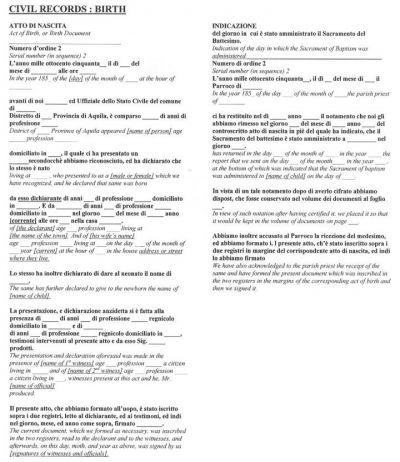Last month you were introduced to the types of civil records available, the history of civil records and where to locate online records. This month our focus is on how to search through digitized record books, basic research tips and sources for translating an Italian birth record (atti di nascita) even if you don’t know much Italian.
Browsing the Record Books
Civil birth records were recorded in books, usually one year per book with each birth record being assigned a sequential number. Whether you use the Ancestors Portal (http://www.antenati.san.beniculturali.it/?lang=en) or www.familysearch.org, you will find the digitized birth records organized by year with an image for each page of the record book. On some images, you may find two to three individuals’ birth records. Most of the record books that were created in the 1820s to late 1890s, will also have an index of the names of the babies in the last few pages of the book. This index is a great resource and it is where you will want to start your search for a record. Some indexes will also show the day and month of birth and the parents’ names. Depending upon how the Italian official recorded the information, names may or may not be alphabetized. I have seen indexes where the names were listed in alphabetical order by first names (nome) and others in which there were organized by surname (cognome), for example all the “S” surnames were grouped together but not necessarily in alphabetical order. Fortunately, most of the later indexes do list surnames in alphabetical order. In some villages, you may also find ten-year indexes of births called the indice decennale. Be aware that earlier years may not have any index at all and you will need to page through the book’s images to find your ancestor’s record.
Research Tips
It’s important that when you are researching to double check parents’ names to ensure you have the right baby. It’s not unusual to have more than one baby born in a village with the same name. This is not the time to assume that your ancestor was uniquely named. When I was searching for my grandfather’s record, I was surprised to find another Antonio Torella who was only a few months older than my ancestor. Imagine if I had stopped looking when I found the first Antonio’s record, I could have added the wrong information to my tree and followed an incorrect ancestral line! If you do not know the parents’ names, then you can try searching for your ancestors’ Italian-born siblings. If you find a sibling’s record, it helps establish that you have the right family.
If you cannot find your ancestor in the index, there are some possible reasons. Perhaps your ancestor was accidentally left out of the index. For this situation, you will need to do a record by record search in the book or at least check the days around your ancestor’s birthdate. Another possibility is that your ancestor’s name was spelled wrong or is different than the name he or she used in America. In this case, look carefully through the index for similar names and then view the actual record to see other biographical data matches. I had one case where a friend’s grandfather was known as “James” in America. We figured that James was probably the Americanized name for Giacomo or Vincenzo (yes Vincenzo is commonly changed to “James” in America). When I searched for a Giacomo or Vincenzo I still could not find his ancestor. Then I did a record for record search of all the babies with the surname of his grandfather, it was then I discovered that my friend’s grandfather was named Rocco Vincenzo at birth. No one in the family had ever heard of him using the name Rocco!
Resources for Translating Italian Records
Sometimes the hardest part in researching civil records is not finding your ancestor’s record but trying to decipher the record’s old Italian script and translating the words. However, the good news is that after you have spent some time viewing these old records, you will find that you will become familiar with the handwriting and the record format. The Familysearch.org website has a “research wiki” with a good aid to help you decipher and translate Italian records: https://www.familysearch.org/wiki/en/Italian_Birth_Document_Translation - this page has a facsimile of a birth record translated into English.
Another good resource is Brigham Young University’s “Extraction Guide.” It’s a lesson on how to find and translate (or extract) the basic details from Italian civil records. It even has a chart that shows how each letter in the Italian alphabet is typically written in script: https://script.byu.edu/Documents/Italian_Extraction_Guide-Chapter_2.pdf
One more helpful resource is this genealogy blog with lots of details on translating a birth record: http://tlngenealogy.blogspot.com/2010/06/how-to-read-italian-civil-birth-act.html
If you come across some unusual words or a section of text, you can always try using Google’s translation tool which is free and easy to use https://translate.google.com/. Next month we’ll continue to explore civil birth records.



